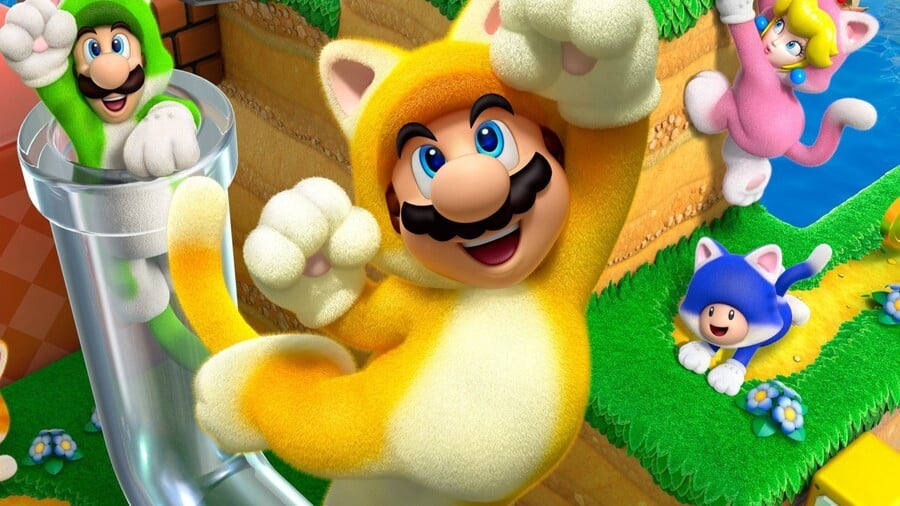
Soapbox features enable our individual writers to voice their own opinions on hot games, trends and topics — opinions that may not necessarily be the voice of the site. In this piece, Jon Irwin discusses how Nintendo seems reluctant to return to the mechanics of Super Mario Bros. 2...
When Super Mario 3D World first released for the Wii U in 2013, the world was a very different place. Brexit was years away, Donald Trump was just another reality TV host, and Nintendo had its back against the wall in a way it never had since entering the video game industry. The year prior it had lost money for the first time in its modern history.
Perhaps it was this urgency, then, that made the company finally attempt what it had neglected to do for twenty-five years: make a follow-up to Super Mario Bros. 2.
Well, not exactly. Super Mario 3D World was the Wii U pseudo-sequel to Super Mario 3D Land on the 3DS — even the creators themselves say so. “To be upfront about it, ever since we started developing Super Mario 3D Land, we thought about making Super Mario 3D World in continuation afterward,” said Koichi Hayashida of what was then known as EAD Tokyo, the studio tasked with making 3D Mario games.
But more than in any Mario game in the intervening years, 3D World borrows major elements from Mario 2 on the NES, including the ability to choose four different characters, each with their own abilities. Luigi flutters his legs and jumps higher. Peach hovers in air for a few extra tics. Toad runs the fastest. There are bonus stages that mirror the post-level slot machine of SMB2, with an arrangement of that very same song. If you progress far enough, a rocket propels you skyward to the next collection of stages; the spaceship is modeled exactly on the Rocketship found in SMB2. And though you can’t pluck turnips out of the ground, special stages star a ground-bound “Captain” Toad who would go on to pluck and toss the veggies in his very own starring title heavily based on the 3D World levels, Captain Toad: Treasure Tracker.
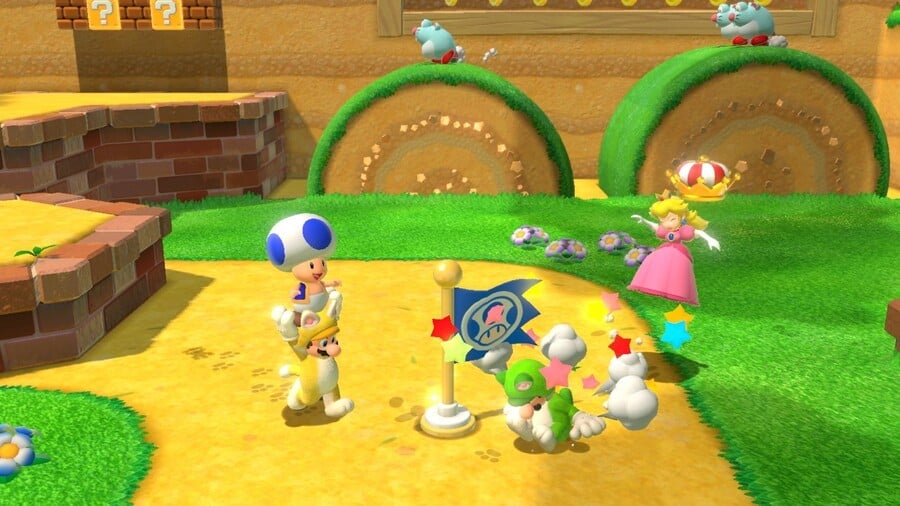
In a way, this is nothing new: Nintendo 'poaching' from Nintendo is a long-held philosophy. But then why hadn’t the core conceit of Super Mario Bros. 2 — four unique characters, pulling and throwing instead of jumping and stomping — ever been re-used? Mario games comprise an extended timeline of iteration; from game to game to game, an incessant series of minor tweaks transform old ideas into seemingly new things altogether, the way a river turns rocks into polished stones. 3D World could be seen as the culmination of this thinking. Kenta Motokura, co-director on the game, had a simple policy: “Let’s put everything in!” So perhaps it’s unsurprising that so many aspects of Mario 2 bubbled up to the surface during 3D World’s development.
why hadn’t the core conceit of Super Mario Bros. 2 — four unique characters, pulling and throwing instead of jumping and stomping — ever been re-used?
Mario 2 itself is merely an adjustment of a previous concept. As any reader of this site no doubt knows, the Super Mario Bros. 2 we got in the West is a reskinned and modified version of the Japanese game Yume Kōjō: Doki Doki Panic from one year prior. That it took a quarter-century for another Mario game to lift SMB2’s core tenet is remarkable; when seen with the clarifying hindsight of over thirty years, the most surprising thing about Mario 2 isn’t that it was a success — which it undoubtedly was, selling over seven million copies — but that a game retooled entirely for the North American market has infiltrated and influenced the entirety of Mario’s output ever since.
Elements first witnessed in the NES sequel crop up everywhere the plumber does, from Birdo’s inclusion in Mario Tennis to Shy Guys driving karts in Mario Kart 7. (The masked introverts are even the default racer when playing a two-player match using Download Only play… but perhaps this is a sign of their low cachet.) Mario’s second Super outing even adorned the very first cover of the company’s official magazine in the West, cementing his status as not a flash in the pan but a turnip-throwing hero to be reckoned with for decades to come. Except he never did throw them again.
Other Mario sequels and spin-offs evolved into entire series of their own: Super Mario Land 2 on the Game Boy featured a new villain named Wario who would go on to star in his own platforming series before turning to more nefarious schemes involving microgames and making money. Super Mario Kart, of course, turned into the system-selling behemoth we know today. Even Mario Teaches Typing got a direct follow-up.
The closest thing to a Mario 2 sequel was the eReader levels for the Game Boy Advance port of Super Mario Bros.3, which dropped in SMB2 gameplay elements like turnips into the classic SMB3 layouts. Not exactly a high-profile release. And big boss Wart? Relegated to a Super Smash Bros. trophy.
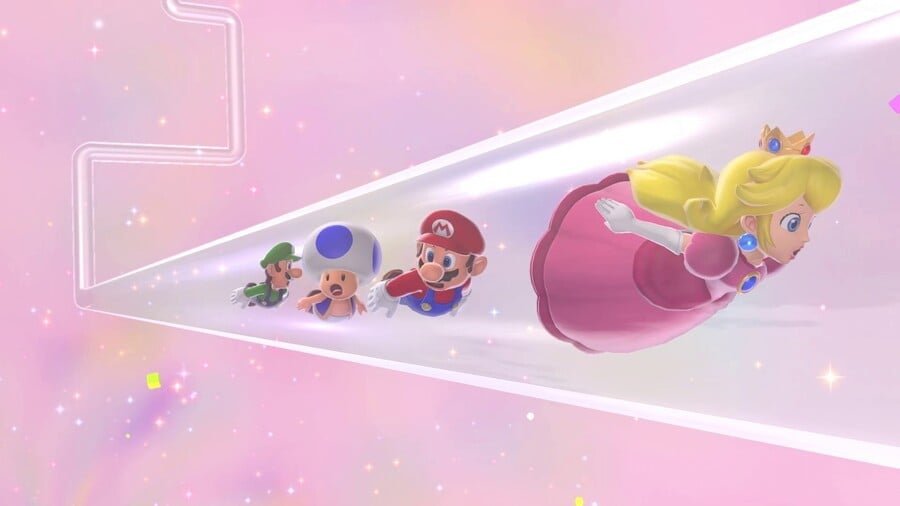
Nintendo’s reluctance to tap into the core of Mario 2 is an odd and beguiling omission. The company has a talent for expertly mining nostalgia for cold hard cash, yet they have ignored a beloved entry that catapulted their flagship franchise into the stratosphere in the West. Other one-off features from classic entries have become mainstays: Yoshi is rideable in games from Super Mario Sunshine to New Super Mario Bros. U, while flight power-ups have returned time and again in various guises since SMB3’s raccoon tail. But the simple ability to pluck an item from the ground and throw it — so instrumental to Mario 2’s identity, yet so mundane an action as to be obvious and expected — has remained off-limits.
Beyond the veggie-plucking mechanic, Mario 2’s four playable characters have also been ignored for curious reasons. Even when New Super Mario Bros. Wii added the ability to play with four people at the same time, Nintendo punted on bringing back Mario 2’s roster. Director of NSMBU Masataka Takemoto explained they wanted each character to feel the same. For a company that values the constant improvement of endless iteration, that answer never felt satisfying. When Super Mario 3D World finally brought back the classic characters and their signature skill set, it brought with it twenty-five years of design knowledge, advancing technology, and a trademark dose of nostalgia.
Director Motokura joined Nintendo in 2000 and was a child when Super Mario Bros. 2, re-released in Japan as Super Mario USA, came out. “The fact that I was raised playing Mario games in my childhood had a big impact on how I make games,” he told The Guardian last year.
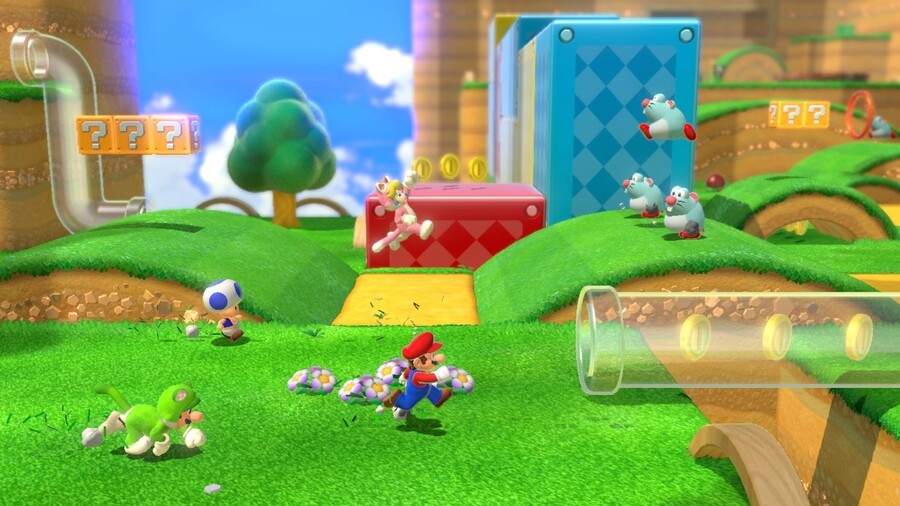
Playing 3D World again in anticipation of the Switch version reminds me how similar it feels to the 1988 NES game, at least in spirit. In the first level of Super Mario Bros. 2, you fall from a door in the sky with little explanation. During 3D World’s opening cinematic, you watch as Mario and company get transported through clear pipes to some unknown land. In both cases the gang is far from the Mushroom Kingdom.
Playing 3D World again in anticipation of the Switch version reminds me how similar it feels to the 1988 NES game, at least in spirit.
Each game plays with verticality in similar ways. Whereas the original Super Mario Bros. had the occasional secret vine waiting to transport you to a cloud platform, Mario 2 had you constantly climbing up or digging down to access new areas. 3D World furthers that style with its Cat Suit power-up, giving each player the ability to climb up walls and reach new heights. Another new power-up, the Double Cherry, also feels plucked directly from Mario 2, where they provided in-level health and extra lives during the slot machine bonus game. Between 1988 and 2013, no other Mario game featured cherries in any significant way.
Now, over seven years later, Super Mario 3D World + Bowser’s Fury gives Switch owners a chance to experience the closest thing to a Mario 2 sequel we’ll likely ever get. Maybe Nintendo was right not to dip its toes back into Sub-con’s waters for so long. In the intervening years since 3D World’s original launch, the world has crumbled. A pandemic rages. Global alliances have fractured. Our political systems are stressed to the point of breaking. Perhaps Nintendo knew the Mario 2 formula was special, or tainted, a broken thing that never meant to exist and would unlock something horrible if revisited. Was it all worth it for another chance to float down on Peach’s parasol? Has Captain Toad throwing a turnip clutched from the earth dulled our collective pain?
Or maybe the resultant chaos emerged only because of their 'half-hearted' effort back in 2013. Our only hope is that the 2021 release completes what they never finished. Bowser’s Fury, a new standalone section exclusive to the Switch port, looks to be a compelling chapter in Mario’s forever war against King Koopa. And though Wart is nowhere to be seen, I can’t help but see this side-story as a nod to Mario 2 and its dream factory, but twisted into something else entirely: a nightmare.
Might Mario wake up at the end of Bowser’s Fury, the way he did in 1988? We could all use a fresh start. Let us hope he, and the rest of us, find closure and a way to move forward. Even if we never again return to Sub-con.
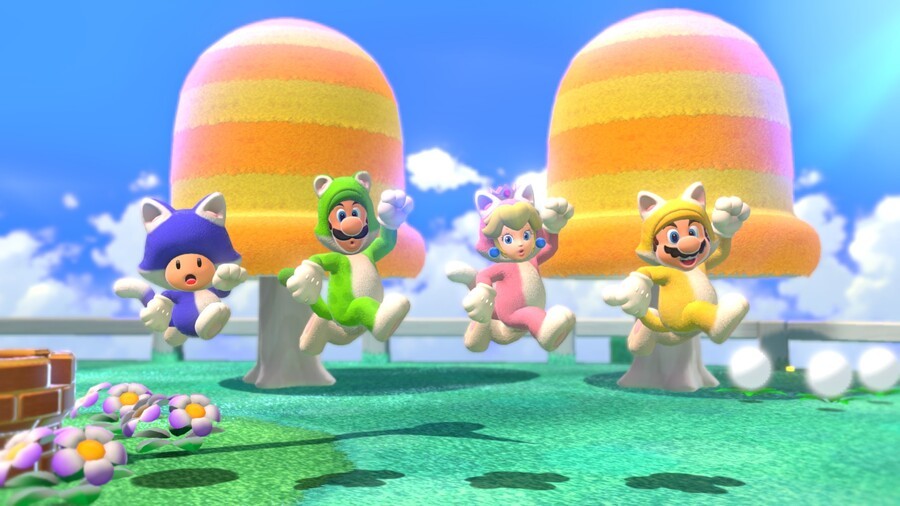
If you're a lover of Super Mario Bros. 2 on the NES, Jon's book on that very subject may be of interest.





Comments 64
Super Mario 3D World needs more Birdo!
I love the NES Mario 2, but had a hard time getting into 3D world for whatever reason. Maybe I'll give it another go someday, but for now I'll just appreciate the classics
I am hoping that Bowser’s Fury is introducing a new franchise..... somewhat like Captain Toad was launched from here.
As a big fan of the game (moreso than most other 2D Marios) the Super Mario Bros 2 nods in 3D World definitely put a smile on my face.
It has been a while since I have played it, but I believe that Super Princess Peach also shared some of the mechanics of SMB2.
I prefer the boomerang suit (or cannon-head) to chucking a turnip. Keeps the momentum going, which is very much a priority in most Marios now.
Mmm, interesting thought experience, but for me the welcoming feeling of sm3dw is about the opposite as the cold blooded beginning of smb2
I always felt that SUPER MARIO 3D LAND was a spiritual successor to SMB3 and that SUPER MARIO 3D WORLD is one for SMB2(NA).
What's interesting is that Captain Toad Treasure Tracker (a game that can basically be seen as a prequel to 3D World, given it's ending) has vegetables in it, as well as Shy Guys, which I don't think appear in any other 3D Mario game. But then, you can't really call that the spiritual successor to SMB2 because... well, you can't jump.
@michellelynn0976 Yessss thank you! I skipped over the latter part but great to know it’s worth getting. I’ll probably ignore the main game as I’ve played it. 41/2 hours isn’t a lot for £60 but it’s just enough - i just can’t miss out on 3D Mario.
Personally this one felt like Mario 3 in 3D to me the way the levels are segmented again and you need certain powerup abilities to find everything. The multiplayer was pretty fun and competitive so looking forward to that working again.
I dont think this game was actually influenced by Mario 2. It's just a 3D version of new super mario bros. Another game with multiple playable characters.
Captain toad is probably more like Mario 2 than this. The pick up mechanic pretty much defines Mario 2
I love Super Mario 3D world for the very reason it has so many dotted lines to SMB2. I played Mario 2 so much as a kid and have such a nostalgic attachment to it. 3D World really is one of the many gems that the WiiU had. I would be curious to see if they release Wind Waker HD with Zelda's anniversary.
@jump That would have been amazing!
“pulling and throwing instead of jumping and stomping”
Wario Land wants a word...
I am certainly under the impression that SMB2 gameplay took so long to get "revisited" because, despite all the franchise significance arguments the article offers, it still originally had NOTHING to do with Mario. It's not Lost Levels "retooled" to go easier on western players, it's an unrelated game retooled (mostly resprited, but with some tweaks and a couple Mario mechanics added, to be fair) for these western players. Not gonna lie, that once made me somewhat biased against it after growing up in the environment of "Darkwing Duck 2", "Chip & Dale 3" and most egregiously "The Lion King" (eponymously titled but ditching the article in some reference materials to avoid confusion with the actual game's NES port). Seeing a juggernaut like Nintendo do official dolling-up like that with Mario - himself a victim of many specimens in Bootlegland - was a rather eyebrow-raising deja vu.😑😆
But the game itself was fun, and its immigrant "legacy" has showed up even before SM3DW indeed (like Peach's hovering mechanic in SMB Melee). Which still leaves its long absence in the proper subsequent Mario flagships not nearly as inexplicable as this soapbox might make it sound.
I love all the nods to SMB2, like the slot machine. 4 player with Peach, the bosses have that SMB2 feel, like Hisstocrat reminds me of Triclyde.
I'd honestly love to see the originals become a remastered updated version. Would be nice to have new animations added, updated graphics and possibly more design to the levels with added worlds and levels that never made it...imagine having an 8-bit game updated to new software making it look more or less...brand new...sort of like Link's Awakening. I'd love this for my favorite one...Super Mario Bros 3
@Mips you are very welcome. hope you enjoy the game as much as i do.
@Mips Yeah, it makes me very excited.
SMB2 was seminal for its time - it was the hot item for Xmas that year, and I was thrilled to get it. I loved how it expanded what a Mario game could be, and played a lot taking turns with friends and siblings.
Being able to play through with 4 different charas was SO COOL! I don’t know how many times I wished they’d retained that mechanic in all the subsequent Mario games. They seem empty somehow by only having Mario playable! That’s my SMB2 bias showing for sure.
The classic 4-chara lineup was my main draw to get 3D World on the Wii U, and having multiplayer just enhanced it.
My Lord, imagine how awesome it would’ve been to do multiplayer back in 88-89!
Games have come a long way, but it’s certainly nice when they recapture some forgotten magic like Nintendo did by resurrecting Super Mario USA features.
I’m most certainly looking forward to picking up my preorder this weekend and diving back into the game with my kiddos!
Interesting article, but the fact that so many paragraphs can be written about this topic says something to me. I'm not sure what it says, to be fair, but still.
Not bashing the article, it was interesting!
They actually did release a sequel called Super Mario Bros 3. Pretty good game, I recommend
I really don't see how this is considered a "sequel" to Super Mario Bros. 2, other than you play as Mario, Luigi, Blue Toad, and Peach in a world other than the Mushroom Kingdom (even then the Sprixie Kingdom is pretty much a clone of it).
The rest of the game is pretty much a standard Mario game. It would also be a stretch to call it a spiritual successor...
@nhSnork Actually, Doki Doki Panic was originally meant to be a sequel to Super Mario Bros. before they got the promotion. They turned it back into a Mario game when it was released internationally. During that period, it was quite common for the second game to be radically different from the first (see: Zelda 2, Castlevania 2).
@Euler the more you know. Were the trademark features conceived before or after the promotion, though? After all, I hear Devil May Cry once started life as a Resident Evil 2 in the making as well. I wonder if, say, a roster of whole four characters would have made it into the game if it had been a Mario sequel project all the way.
Shy Guys have also been used extensively in the Mario Party games.
@Slowdive In what way is it more like SMB3? I've not played it yet but both these comparisons have me VERY excited!! It has the SMB2 music?! 😱
Each to their own regarding the nod to SMB2. I am looking forward to receiving my copy of SM3DW later on next week, however, I do feel it is about time we had a whole new mario game (2 to be precise, 1x2D and 1x3D). Also we are sooooo long overdue a new MK!! Come on Nintendo get your ar*e in gear for a Christmas release this year on all 3 games??!!
@nhSnork Not sure about the four characters. But more vertically-oriented levels and being able to pick up and throw characters was part of the original plan.
https://www.wired.com/2011/04/super-mario-bros-2/
Calling it even a spiritual successor to SMB2 is a real stretch to me. Anyone reading this who hasn't played one or the other shouldn't expect them to really be anything alike besides the few minor things like have 4 characters to pick from. Even the character differences were present in other games, like Luigis higher jump which predates SMB2.
Don't get me wrong, they're both great games, but really nothing alike.
I'd love a successor to SMB2, though. Give Bowser a break and bring back Wart for a romp.
Playing this on the Wii U totally felt like a SMB2 sequel to me, too!
"In 2013, the world was very different. Donald Trump was just another reality TV host"
Oh for God's sake, please don't bring political talk here. I don't care about politics and I'm sick of hearing it everywhere constantly. Mario has nothing to do with that stuff.
@Euler makes sense. Picking and throwing showed up in later flagships like SMW, too.
At least one song in Bowser's Fury starts off with a few notes of Super Mario Bros. 2's overworld theme. You can hear it in one of the videos on the Nintendo Life YouTube channel.
Mario 2 suuuucked. Wasn’t even a Mario game during development, and wasn’t made by Nintendo.
Cool story, bro.
Super Mario Bros 2 was my first game, as a pack-in title with a NES I discovered under the tree one Christmas (the same year also gifted me a Game Boy with Tetris bundled - amazing year, even if most of my friends were on the SNES at that point). Of my friends who still owned a NES, it was all about Super Mario Bros and Super Mario Bros 3. Most of them hadn't heard of Super Mario Bros 2 and thought it sounded weird. Indeed, I was confused when I started playing it to find there was no timer, no flagpole, no Bowser/Kooper (lack of internet meant I had no idea what his name was at that time), but I learned to love it as just a really well-made game. I remember getting the Wii U in early 2014 specifically to play Mario 3D World and the first thing that struck me was the different abilities of each character. Really great to see that back. Looking forward to Friday!
I don't think it's the closest we'll ever get. I refuse to believe Wart won't make a come back.
Worthy of note though also. The toad they used was blue like his original NES appearance!
Yeah this felt very "SMB2" as SM3DL felt very "SMB3". I'm just glad that SMB2 got more love, no matter how muted it may have been.
Oddly enough a rom editor exists to make your own levels in smb2 , and the first hack that came out was Return to Subcon. It's pretty cool. I'd suggest watching it if you're interested, it's by glitchcat7
I dunno, it seems like a classic Nintendo move to just come out with a SMB2 homage out of nowhere after showing zero interest in doing so for twenty years
Shy Guys were also in Link’s Awakening - the true sequel to SMB2
I thought the similarity I noticed with SMB2 was just in the character selection, but this article touched on quite a few details. Nintendo tends to be weirdly selective when it comes to certain elements that return, and I think it's just coming from what the person working on it likes. Assuming it's all arbitrary and just based on the devs preferences makes sense, even if it's an unsatisfying conclusion.
I thought SMB2 didn't really shown up much and assumed that it was because the game was reskinned from a different game, but elements of it pop up constantly. Bob-ombs, Shy Guys, Birdo, and to a lesser extent Snifits all premiered in that game and have shown up in varying levels over the years. The preference thing makes sense with how they appear, especially with how Wart's only reappeared in his cameo appearance in Link's Awakening. You'd think it was the black sheep of the series, but Nintendo's just really subtle about the influence it's had.
I’m a big fan of Mario 2 as well, and noticed all of the references the first time around. It kinda bums me out that we don’t see more Mario 2 characters in games like Mario Kart. I have nostalgia for the old Super Show cartoon, and villains like Mouser and Fry Guy. I’m glad we got the game as Mario 2; and not Doki Doki Panic. It has always felt like a Mario game to me, and I prefer it that way.
Great article! It inspired me to fire up Super Mario Bros 2 on my Retro USB AVS. It's still a fantastic game. Super Mario Bros 2/USA was always my favorite 2D Mario. I still remember being so excited for its release. It was so different from the original in that it gave the player a lot of freedom to explore. I always felt that Super Mario 64 was a follow up in the amount of freedom it gave the player. I can't wait to play through 3D World again.
Super Mario Bros 2 is quite possibly the most influential Mario game to date, even though SMB3 remains as the most memorable entry. A LOT of mechanics in 3D Marios originated in SMB2.
My copy just arrived at the parcel station, super excited to play it with the Mrs tonight These games are just pure, distilled joy! Looking forward to spotting these nice little nods to SMB2 hidden in there.
Almost bought a WiiU for this game, so glad I was uncharacteristically patient.
True Story: When I was little I use to believe that Super Mario Bros. 2 was based on the Super Mario Bros. Super Show! since the game featured the same four main characters from the show and the same baddies as well not to mention I had seen the show years before I got to play SMB2. I didn't know the game was an adaptation of another game until I read it in one of EGM's magazine when the GBA launch.
The first time I went to my friend's house they got an NES and a few games, I actually went to sleep over and the next day we watch the Super Mario Bros. Super Show at his house, I told him wouldn't it be nice if this show also had a game, you know like Super Mario Bros. 3 cause at the time SMB3 and its show was the only thing I had seen and play and he told me yes there is one and I was like you're kidding right and he said it again, yes there is one, it's called Super Mario Bros. 2 and you can be Mario, Luigi, the Princess, or Toad (just like the show).
He show me the game, we pop it into his NES, and I was blown away, it's true. When I reach Wart at the end of the game, I use to call him King Koopa cause let's face it King Koopa in the show look nothing like the ones in the game so I couldn't tell if he's suppose to be Wart or Bowser so I just call both King Koopa instead. Another interesting detail is that Mario wore the same outfit in the cover of SMB2 as he did in the show and different from the other games. In the cover he wore red overall and blue shirt just like the cartoon whereas in the other games he wore blue overall and red shirt.
@Deadsea1993 Not sure what the problem is. It isn't a lie 🤣
@XBontendo I had the same, but when you start playing with others in COOP, then it becomes a completely different game and is incredibly fun.
The Mario Bros. 2 stage in Smash is called Mushroom kingdom 2, which annoys me.
It's not the mushroom kingdom, it's subcon.
Super Mario Bros. 2/USA is heavily based on Doki Doki Panic,
and Doki Doki Panic is loosely based on Aladdin,
and Aladdin is most definitely based on Sonic the Hedgehog,
so I’d argue that the true spiritual successor to Super Mario Bros. 2 is actually Sonic and the Secret Rings for the Nintendo Wii.
#ConvincingArgument
While it was a nice change of pace for one game, the SMB2 style of gameplay of picking up and throwing just isn't as good as the standard jumping and squashing gameplay; so it's no wonder that Nintendo never brought that part of SMB2 back for another game, at least aside from Peach's and now Daisy's Down-B Special in the Super Smash Bros. games.
I'm always amused at how the guys make sure they don't look up Peach's dress while traveling through that initial pipe in "SM3DW."
Not sure how any Mario games are deemed "sequels". Just because they had a number after them didn't mean they were correlated with anything. SMB2 was a dream that the 4 of them had making it a one-off adventure. Maybe the rest is just dreams as well, but as far as SMB2 is concerned, Birdo and Shyguy aren't actually real, they were only figments of Mario's imagination. How they came to be real in actual stories is beyond me.
It's been stated officially that they are all considered "actors" in the games so it's possible that beyond SMB1 all subsequent games are dreams/nightmares spinning off from the first storyline. Bowser is actually still defeated, but shows up in Mario's dreams to torment him still.
@Tandy255 I wish that game was available to pick up besides from third parties who charge $100++ for it
@Ks123 It would take some work to port Super Princess Peach to Switch, but for a DS game, the touch screen wasn’t used much. The emotions could be remapped to buttons.
It is also slightly problematic that when the female character got her own game, her attacks and defenses were defined by her emotions.
@GigaMermaid shy guys and the propeller variant "Fly Guys" appears in Super Mario 64...
@MrGuinea the fact that they are a dream in SMB2 (It was just Mario dreaming btw, not the four of them), does not negate their existence.
I sometimes dream about sharks, and I'm sure they exist.
Everyone is forgetting the radishes in the Mario Odyssey cooking kingdom
@Ghost_of_Hasashi the color scheme of Mario was the same in SMB1 as in SMB2. Blue shirt, red overall.
@Tandy255 I’ve never played it so this is interesting info. I think there’s a good conversation to be had there about why there are “girl” games and “boy” games. Maybe that’s why it has never been added to the 3DS eShop and never received a sequel.
More importantly, was it even a good game?
@Ks123 I think it was a good game. I enjoyed playing through it once, but didn’t feel the need to keep it.
It shouldn’t be forgotten. Somebody made the point that her having emotions wasn’t necessarily bad. She was in control of them and used them.
@Tandy255 Cool, I have a copy. I should play it.
Tap here to load 64 comments
Leave A Comment
Hold on there, you need to login to post a comment...